2017--2017学年译林版选修六unit 2 what is happiness to you grammar课件(89张)
文档属性
| 名称 | 2017--2017学年译林版选修六unit 2 what is happiness to you grammar课件(89张) | 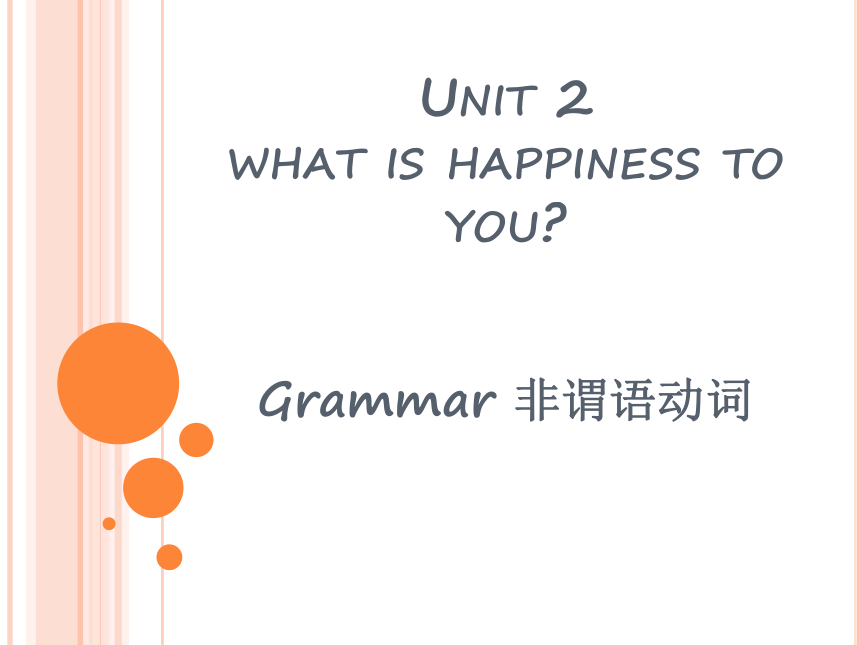 | |
| 格式 | zip | ||
| 文件大小 | 702.0KB | ||
| 资源类型 | 教案 | ||
| 版本资源 | 牛津译林版 | ||
| 科目 | 英语 | ||
| 更新时间 | 2017-10-21 19:00:47 | ||
图片预览

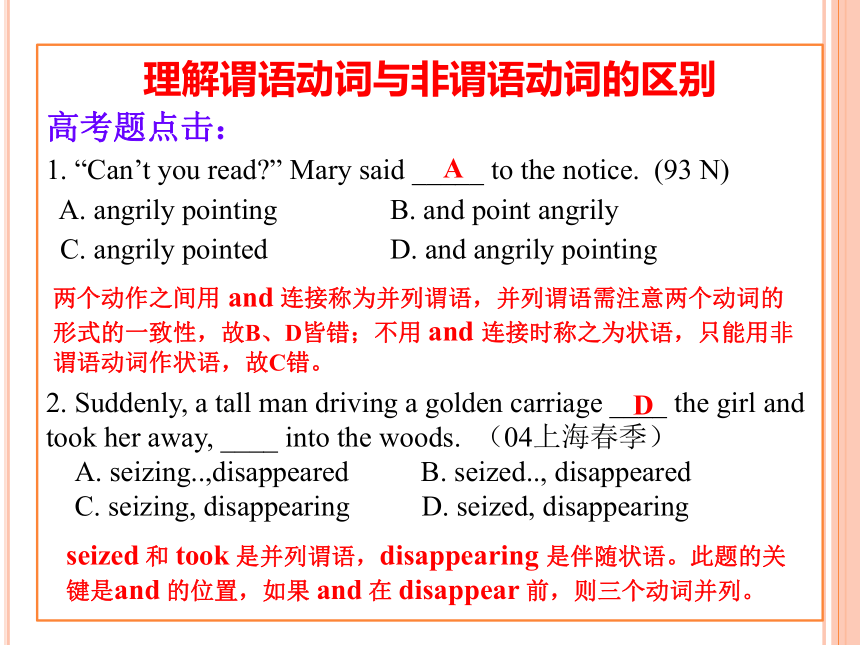



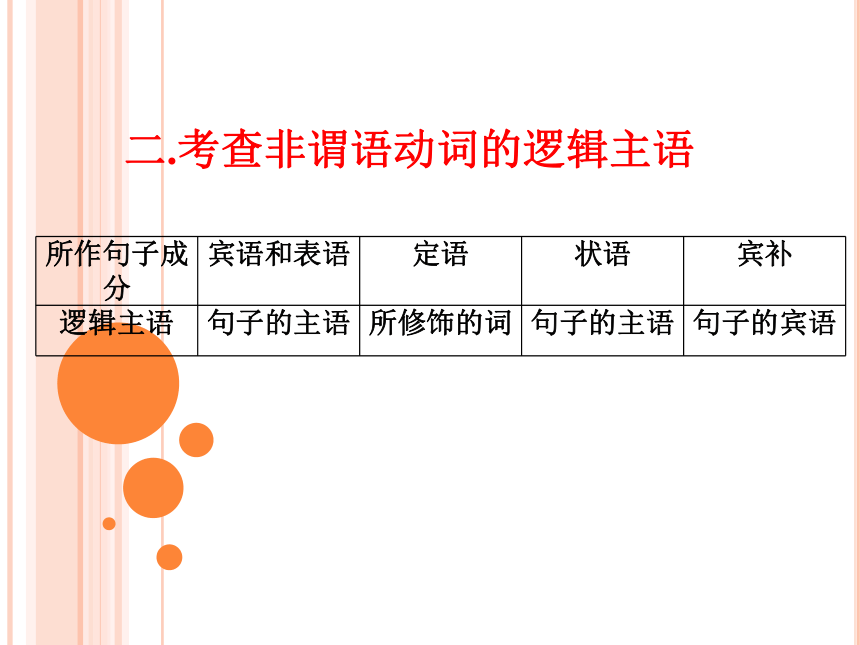



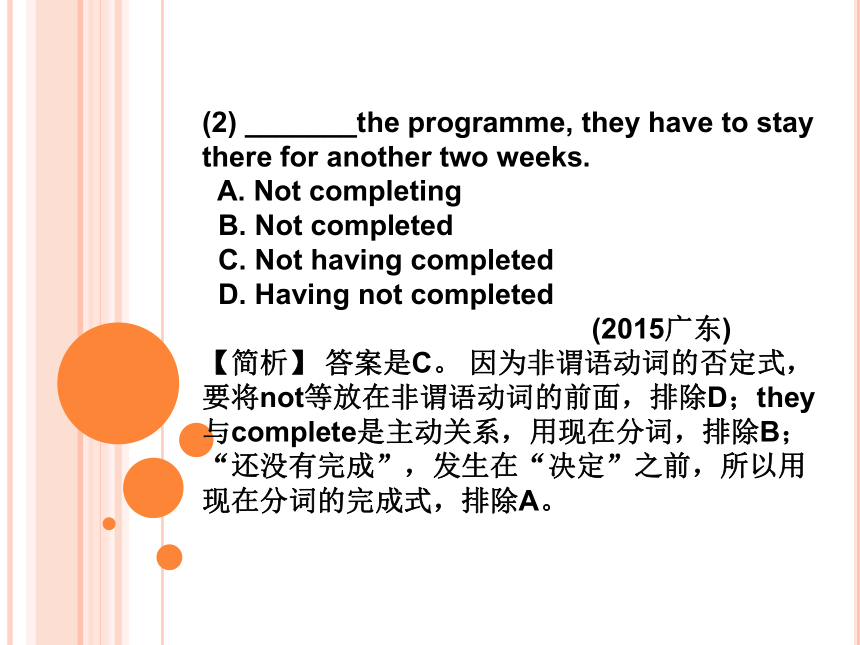

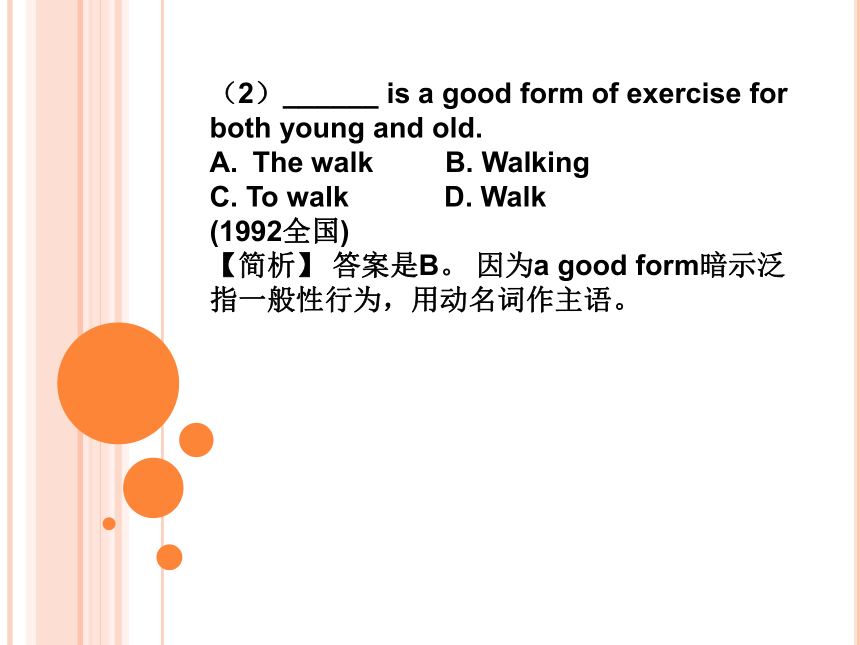
文档简介
课件89张PPT。Unit 2 what is happiness to you?Grammar 非谓语动词理解谓语动词与非谓语动词的区别
高考题点击:
1. “Can’t you read?” Mary said _____ to the notice. (93 N)
A. angrily pointing B. and point angrily
C. angrily pointed D. and angrily pointing
2. Suddenly, a tall man driving a golden carriage ____ the girl and took her away, ____ into the woods. (04上海春季)
A. seizing..,disappeared B. seized.., disappeared
C. seizing, disappearing D. seized, disappearing
两个动作之间用 and 连接称为并列谓语,并列谓语需注意两个动词的形式的一致性,故B、D皆错;不用 and 连接时称之为状语,只能用非谓语动词作状语,故C错。seized 和 took 是并列谓语,disappearing 是伴随状语。此题的关键是and 的位置,如果 and 在 disappear 前,则三个动词并列。AD非谓语动词考点全解一.考查非谓语动词的时态和语态
[链接高考]
All these gifts must be mailed immediately _____ in time for Christmas. (2015辽宁)
A. in order to have received
B. in order to receive
C. so as to be received
D. So as to be receiving
【简析】 答案是C。 因为句子主语All these gifts与不定式receive式被动关系,只有
选项C是被动式。_______ from other continents for millions of years, Australia has many plants and animals not found in any other country in the world. (2015湖北)
A. Being separated
B. Having separated
C. Having been separated
D. To be separated
【简析】 答案是C。因为Australia与separate是被动关系,且separate发生在谓语动词has之前,所以用现在分词的完成被动式作原因状语。二.考查非谓语动词的逻辑主语[链接高考]
While watching television, _______.
A. the doorbell rang
B. the doorbell rings
C. we heard the doorbell ring
D. we heard the doorbell rings
(2015全国III)
【简析】 答案是C。 因为watching 的逻辑主语一定是句子的主语,能作其主语的只有选项C和D 中的we,有因为在hear后能作宾补的应是省略to 的不定式。(2)In order to make our city green, _______.
A. it is necessary to have planted more trees
B. many more trees need to plant
C. our city needs more trees
D. we must plant more trees
(2002上海春)
【简析】 答案是D。 作目的状语的不定式的逻辑主语应为句子的主语,选项中的主语能作不定式的逻辑主语的只有we。三.考查非谓语动词的否定式
[链接高考]
Victor apologized for _____ to inform me of the change in the plan.
A. his being not able B. him not to be able
C. his not being able D. him to be not able
(2015上海春)
【简析】 答案是C。 在介词for后作宾语用动名词,排除B和D;非谓语动词的否定式式将not放在非谓语动词之前,排除A;只有选项C 正确,题中not放在动名词being 之前,逻辑主语his之后。(2) _______the programme, they have to stay there for another two weeks.
A. Not completing
B. Not completed
C. Not having completed
D. Having not completed
(2015广东)
【简析】 答案是C。 因为非谓语动词的否定式,要将not等放在非谓语动词的前面,排除D;they与complete是主动关系,用现在分词,排除B;“还没有完成”,发生在“决定”之前,所以用现在分词的完成式,排除A。四.考查非谓语动词作主语和表语
[链接高考]
It’s necessary to be prepared for a job interview;_____ the answers ready will be of great help.
To have had B. Having had
C. Have D. Having
(2015北京)
【简析】 答案是D。 因为动名词短语作主语,表示一般的情况。(2)______ is a good form of exercise for both young and old.
The walk B. Walking
C. To walk D. Walk
(1992全国)
【简析】 答案是B。 因为a good form暗示泛指一般性行为,用动名词作主语。注:(1)有时这种区别并不是很严格。但要注意:主语和表语要用同一种形式;平行结构中要用同一种形式。
[链接高考] Fishing is his favourite hobby, and _____.
A. he’d like to collect coins as well
B. he feels like collecting coins, too.
C. to collect coins is also his hobby
D. collecting coins also gives him great pleasure.
(2001上海)
【简析】 答案是D。 因为and连接两个并列句,前一分句用动名词作主语,与之并列的后一分句也应用动名词作主语。2.在seem, appear, prove(结果是,后来表明),remain(尚须),grow (达到……的程度)等连系动词后,可用不定式作表语,但不用-ing形式作表语。
[链接高考]I think you’ll grow _____ him when you know him better.
A. liking B. to be like
C. to like D. to be liking
(2015江西)
【简析】 答案是C。 因为在表示“达到喜欢的程度”的grow后用不定式作表语,排除A;like作喜欢讲是动词,前面不用be,排除B,like一般没有进行式,排除D。五.考查不定式和动名词作宾语
表示“需要”的need, want和require等后的动词形式这时,其主语一般是事物,其后的动词形式可以是不定式的被动式,也可以是动名词的主动式。
[链接高考]There is a new problem involved in the popularity of private cars ____ road conditions need _______.
A. that, to be improved B. which , to be improved
C. where, improving D. when, improving
(2015上海)
【简析】 答案是A。 因为“公路状况需要改善”,need后接improving或to be improved都可以。后面的从句应是problem的同位语,应用that引导。六.考查不定式,现在分词和过去分词作状语
[链接高考]
(1)My advisor encouraged______ a summer course to improve my writing skills.
A. for me taking B. me taking
C. for me to take D. me to take
(2015北京)
【简析】 答案是D。 因为me 与take式主动关系,且take 发生在谓语动词encouraged之后,要用不定式作宾语,即encourage sb. to do sth。Paul doesn’t have to be made ______. He always works hard.
learn B. to learn
C. learned D. learning
(1995全国)
【简析】 答案是B。 因为在使役动词make, let, have后,一般用不带to的不定式作宾补,但在其被动式后作主补的不定式要加to。七.考查不定式,现在分词或过去分词作状语在表示时间,条件,让步,方式或伴随情况等时,通常要用分词,不用不定式。句子主语与现在分词在逻辑上是主动关系,句子主语与过去分词在逻辑上是被动关系。注意:现在分词的被动式,习惯上不作伴随状语。
[链接高考] (1)Daddy didn’t mind what we were doing, as long as we were together, _____fun.
A. had B. have C. to have D. having
(2015重庆)
【简析】 答案是D。 因为作伴随状语不能用不定式,we与have fun是主动关系,要用现在分词。[链接高考] (2)______ in the queue for half an hour, Tom suddenly realized that he had left his wallet at home.
To wait B. Have waited
C. Having waited D. To have waited
(2015北京)
【简析】 答案是C。 表示时间不能用不定式,而要用现在分词。Having fun=After he had waited…[链接高考] (3)When ______ help, one often says, “Thank you.” Or “ It’s kind of you.”
A. offering B. to offer
C. to be offered D. offered
(2015福建)
【简析】 答案是D。 某人说“谢谢”应当是他被提供了帮助,所以要用过去分词。When offered help = when he is offered help…2. 不定式和分词表示原因的区别
表示原因时,分词短语常放在句首,也可放在句末,多用逗号格开;不定式短语却只能放在句末,但不用逗号,且多用于表示情绪或情感反应的动词,形容词之后。
I’m surprised to see you here .
[链接高考] _______ in a white uniform, he looks more like a cook than a doctor.
A. Dressed B. To dress
C. Dressing D. Having dressed
(2015湖南)
【简析】 he 和dress是被动关系,要用过分词作原因状语,故选A. Dressed in … = As he is dressed in …3.不定式和现在分词表示结果的区别.
不定式表结果,其动作发生在谓语动词之后,往往表示未曾预料到的或令热不快的结果,不定式前常加only;另外,还用于too…to, enough to, never to, so/such… as to等固定结构中。现在分词表示的结果,式伴随谓语动词的发生而产生的自然结果(同时发生),有时在前面加上thus,谓语动词于现在动词的动作式因果关系。[链接高考] (1) He hurried to the station only _____ that the train had left.
A. to find B. finding
C. found D. to have found
(2015广东)
【简析】 答案是A。only后接不定式,表示“结果却,不料”,hurried和find是先后发生的两个动作。[链接高考](2)Oil prices have risen by 32 percent since the start of the year, _____ a record US57.65 a barrel on April 4.
have reached B. reaching
C. to reach D. to be reaching
(2015山东)
【简析】伴随着谓语动词的发生而产生的自然结果,用现在分词作结果状语。故选B。
作目的状语或者在形容词后作状语只能用不定式
[链接高考] (1) ____ more about university coursed, call (05920)746-3789.
A.To find out B. Finding out
C. Find out D. Having found out
(2015浙江)
?【简析】作目的状语要用动词不定式,故选A。(2)You were silly not ______ your car.
A. to lock B. to have locked
C. locking D. having locked
(2015 湖南)
【简析】在形容词(silly)后作状语,用不定式;“没有锁车”发生在谓语之前,用完成式,故选B。非谓语动词的运用与比较不定式动名词分词非谓语动词1 非谓语动词的词性
及句法功能a. 动词:To run fast 状语
To smoke a cigarette 宾语
Feeling hungry 表语1。非谓语动词的词性及
句法功能
2。句法功能的区别:
3。非谓语动词的形式
4。非谓语动词的复合结构b. 其它词性:√√√√√√√√√√√√√√√√√√√√√XXXX2. 句法功能的区别:1 主语动名词
不定式In many countries, shaking one’s head means “no” and nodding means “yes”.
To write a science fiction is his wish.It’s dangerous to play/playing with fire.1.两者作主语一般可以通用,意义没有多大差别。2. 不定式一般表示特定的,具体的行为,特别是
表将来的一次行为;动名词常表示抽象的,一般
的行为。It is no use _______(argue) with him about that.arguing3. 在含有no, -less,常用动名词短语作主语。
Eg.
It is no use doing….; It is useless doing…
It is no good doing…; It is no help doing…非谓语动词作主语时要注意以下两个重要问题:第一是并行结构问题,如:Seeing is believing. / To see is to believe.
第二需要注意一些结构:
A) 在 It’s no use (good; value; importance) 等结构中只用动名
词作主语。如:It’s no use quarrelling with such a fellow .
注意比较:There’s no need to tell him about it.
B) 在 It’s + adj. 结构中都用不定式作主语。注意两种句型:
It’s easy (difficult, hard, important, possible, impossible,
comfortable, necessary, better; the first, the next, the last,
the best, too much, too little, not enough) 后加 for sb. to do
It’s kind (nice, stupid, rude, clever, foolish, thoughtful,
thoughtless, brave, considerate (考虑周到的), silly,
selfish (自私的) )后加 of sb. to do3. The purpose of new technologies is to make life easier,
_____ it more difficult. (99 N)
A. not make B. not to make C. not making D. do not make
B动词不定式短语 to make life easier 及 not to make it more
difficult 都作 purpose 的表语。非谓语动词作表语时要特
别注意两个问题,一是并行结构问题,二是时间问题。一般来说,不定式作表语都表示该动作发生在将来,故在表示“目的、愿望、梦想、需求”等名词作主语时其表语应该用不定式。动名词作表语一般用来表示“身份、职业”等。2. 表语不定式
动名词
分词The story is moving.
A way of saying “I am hungry” is patting the stomach before a meal.
My task this class is to teach you how to grasp the grammar.现在分词作表语表示主语的特征,相当于形容词,因此
它前面可用very, quite 或表示比较意义的more, most 来
修饰;动名词作表语说明主语的内容,可以与句中的主语交换位置。由于动名词具有明显的名词特征,故不能用以上表示程度或比较意义的词修饰。不定式则表示某一次具体的行为,类似于作主语。His hobby is playing football.
Or: Playing football is his hobby.
The volleyball match we watched was very exciting.2. 动名词作表语时,该句的主语有很大的局限性,主要是job, work, task, duty, wish, happiness, 等;现在分词作表语时的主语范围广泛得多。He
The scientific novel
To read a novel at the moment
What he saidis interesting.总结:非谓语动词做主语和表语的区别:3. 宾语动名词
不定式根据习惯搭配和语义区分习惯接动名词作宾语的有:mind, finish, enjoy,
avoid, risk, consider, practise, suggest, advise, miss, appreciate, imagine, put off, keep(on),
give up, insist, be used to, look forward to, stick
to, devote one’s life to, be busy, be worth, can’t
help, excuse, escape, admit(承认),delay, keep,
risk, object to(反对), pay attention to, etc.特殊动词接“动名”,使用它们要记清,
“放弃”“享受”可“后悔”,
“坚持”“练习”必“完成”,
“延期”“避免”非“介意”
动名介宾不能忘
掌握它们你必明。后只接动名词做宾语的一些常用特殊动词记忆口诀习惯于后接动词不定式而不接动名词作宾语的动词有:want, wish, hope, expect, promise,
pretend, decide, manage, refuse, learn, agree,
plan, offer, long, demand, help, manage,
prepare, learn, determine, prefer, intend, etc. 动名词与不定式的不同含义:
be afraid to do
不敢、害怕、胆怯去做某事
be afraid of doing
担心、恐怕出现
We are never afraid to lay down our lives for the right cause.
为了正义的事业我们绝不怕牺牲自己的生命。
She was afraid of waking her husband up. 2) forget to do sth.
忘记去做某事(未做)
forget doing sth.忘记做过了某事(已做)
3)remember to do sth.
记着去做某事(未做)
remember doing sth.记着做了某事(已做)
Do you remember ______(meet) me at a party
last year?
You must remember ______( leave) tomorrow.
4) regret to do sth.
遗憾地说/告诉…
regret doing sth. 后悔做了…
I regret _____( go ) to his home town.
I regret _____( tell ) you the truth.
5) stop to do sth.
stop doing sth.
6)try to do sth.
try doing sth.
7) mean to do sth.
mean doing sth.
8) go on to do sth.
go on doing sth.
9)can’t help doing sth.
情不自禁,不禁
can’t help (to) do sth.
不能帮忙做…
10. permit / allow / advise + doing sth.
+ sb. to do sth.
11. start / begin / continue / like / love / hate + to do sth.
+ doing sth.
但有些动名词在句中是主动形式,却有被动含义
The house requires / needs / wants repairing.
The book is worth reading.
非谓语动词学习总结
可以接不定式和动名词作宾语的动词:4. 定语动名词
分词
不定式Do you know the man talking with a black there?
The carrying pole reminds me of our bitter days in the past.
There will be many people to help you. =who is talking …The pole for carrying things1 所含时态意义the laughing audience
Have you read the book 20,000 Leagues Under the Sea written by Jules Verne?
The next boy to play went to the piano.
He is always the first one to get up.分词-正在进行或发生了的动作
不定式-尚未实现的将来的行为或表示一般性 叙述而无一定的时间性。
动名词-表示被修饰词的目的或用途
2 逻辑关系:
分词- 主谓关系(可改成定语从句)
动名词-表示被修饰词的目的或用途
不定式-多种逻辑关系The labto be built
being built
built last yearThe rising sun---the sun that is rising
A broken glass--- a glass that is broken
The light is off. Please give me some candles to give light. ( some candles that give light)
主谓关系
A hard job to do---a hard job that one must do
动宾关系
A place to rest---a place where one can rest
动状关系
The plan to open up rice fields
同谓关系3. 现在分词和过去分词falling leaves
fallen leavesexiting news
exited students-ing 令人…; -ed 表示所修饰词本身的特征a disappointing voice; a disappointed voice注意:1。现在分词作定语时,表示动作正在进行或与谓语动词的表示的动作几乎同时发生。如两个动作有先有后,一般不能用现在分词作定语,而要用定语从句。
The teacher criticized the student
who had broken the window.
2. Yesterday, mother told me an event which happened five years ago. 非谓语动词作定语时要注意以下区别:
分词作定语时与其所修饰的名词有逻辑上的主谓关系;
动名词作定语时只表示用途、场所等意义;
不定式作定语时要注意以下一些固定结构:
在 time, chance, right 等名词后;
在序数词后;
在 wish, need, demand, requirement …等词后。
D)表示被动意义的非谓语动词作定语时的用法:
done 表示已经完成的动作
to be done 表示尚未开始的动作
being done 表示正在进行之中的动作总结:非谓语动词做定语的区别:5.宾语补足语不定式
分词使役动词:make, have, let, hear, listen to, see, watch, notice, observe, look at, etc.
感觉动词:find, see, watch, notice, hear, feel, etc.It’s cold out side, we had the fire burning all night.
Mum had him wash the plates.
I saw him go upstairs.
I saw him going upstairs(已经上去了,全过程)(此刻的行为)总结:非谓语动词做宾语补足语的区别6。 状语不定式
分词1.Every day he climbed to a high rock near his cave to keep watch.
2. Two years later, her father disappeared , never to return.
3. I’m very glad to have this stamp again.
4. It is too dark for us to see anything in the room.
5. He is old enough to look after himself.目的结果原因程度程度不定式主要作目的,结果和程度状语1. Once fleeing Germany, Einstein went first to France, then to Belgium…
2. Being a shy man, Einstein didn’t attend the great celebration.
3. The trainer appeared, followed by six little dogs.
4. Given more time, I can do it better.
5. Weighing almost 100 jin, the stone was moved by him alone.
6. The boy stood up, obliging me to rise, too.时间原因方式,伴随条件让步结果1.分词在句中主要作时间,原因,方式或伴随,条件,让步,结果状语。分词和不定式作结果状语My grandfather lived to see the liberation of China.
Tony’s father died, leaving him a lot of money.
He went home, only to find his money stolen.(动作行为)(状态)2。不定式强调动作发生的过程或未曾料到的不愉快的结果;分词主要表示动作发生后所引起的结果状态或必然产生的结果。现在分词和过去分词作状语Many people come to theme parks, looking for thrills and entertainment.
Once published, his work became famous for the absence of rhyme at the end of each line.主语是分词所表示动作的执行者分词用doing / having done,如果是分词所表示动作的承受者,分词用done / having been done。注意:1。状态动词或相当于状态动词的一些词。She sat there, lost in thought.
After a day’s work, he went home, tired out.2. 一些使役性动词,如:disappoint / excite / surprise / move / interest / puzzle… 。The game ________ (interest) the boys. ?
The boys are ________________ the game.
The game is __________.
I wonder why football _____ boys.
A. has interested B. is interested in
C. interesting D. interested
_______ (excite) at the news, the boys rushed to watch the game.
________ (Fill) with joy, I started off. interestsinterested ininterestingAExcitedFilled
3 不定式在作表语/ 补语的形容词后面作状语,用主动形式表被动意思。
This question is difficult _______ (answer).
Do you think him easy______ (work) with?
We find this rule hard _____ (remember).
4 有些分词已经转变为独立成分, 含有“泛指”意义,在句中常作插入语。如:generally speaking, judging from…, talking of…, supposing, considering…Judging from his accent, he is a southerner.to answerto workto remember注1:分词作状语时,其逻辑主语须与句子的主语一致,构成主动或被动的关系。
注2: 表示时间关系的分词短语有时可由连接词while或when引导。
注3:有时,”with + 名词(或代词宾格)+ 分词”的结构表示伴随状况。
注4: 当分词的逻辑主语与主句的主语不同时,分词须有自己的主语,构成独立主格结构。(见后)While watching TV, he heard someone shouting
shout for help.With the work done, he went home.Weather permitting, we’ll go outing tomorrow.Moved by his words, tears came to my eyes.3 非谓语动词的各种形式:(以动词do为例)不定式分词To doTo be doneTo have doneTo have been doneTo be doingTo have been
doingdoingBeing doneHaving doneHaving been done1。不定式的时态与语态:
1)一般式:不定式表示的动作常与谓语的动作同时(或几乎同时)发生,或在它之后发生。
I saw him go out.
I plan to attend the meeting to be held tomorrow.
2)进行式:不定式表示的动作正在进行。
I’m very glad to be working with you.
3)完成式:不定式的动作发生在谓语动词之前
I’m sorry to have kept you waiting.
The article is said to have been read by many people. 2。动名词的时态和语态
1)动名词的时态:一般式和完成式
如动作没明确表示出时间是与谓语同时发生或在谓语之前发生,用一般式。
We are interested in _____ (play) chess.
如动作发生在谓语动词所表示的动作之前,通常用完成式。
I’m sorry for not _____ (keep) my promise.
但在某些词后,常用一般式,尽管其动作是在谓语所表示的动作之前发生。
On hearing the bad news, she cried.
I’ll never forget seeing that film for the first time. 2)动名词的语态
doing ? being done
having done ? having been done
He was afraid of _____ (leave) at home.
Xu Benyu insisted on being sent to the mountain area to serve the children there.
3. 现在分词的时态及语态:分词的动作如发生在谓语动词之后doing,用一般式,如发生在谓语动词之前,用完成式having done。 Having enjoyed the rides at the Headland, visitors can take a shuttle to the Lowland.But theme parks also try to make sure that visitors leave knowing more about their theme.
4 非谓语动词的复合结构如果要说明不定式表示的动作是谁做的,可以在不定式前加一个由for/of 引起的短语。
It is easy for the students to read.
It will be a mistake for us to help you.1 不定式的复合结构: for/of sb. to do sth.It’s wrong of him to speak bad behind others.2 动名词的复合结构:
名词所有格(Mary’s)/形容性物主代词(my)+动名
逻辑主语是有生命的名词:作主语时,须用名词所有格或形容词性物主代词;作宾语时,也可用普通格或人称代词宾格。
Tom’s (His) coming is what we have expected.
She didn’t mind Jack/ Jack’s (him/ his) coming here.2. 逻辑主语是无生命的名词:只用名词普格。
Is there any hope of our team winning the match?
3. 逻辑主语是指示代词或不定代词 this , that, somebody, someone, nobody, none, anybody, anyone时,只有普通格。
She was disturbed by somebody shouting outside.3.分词的独立主格结构
分词短语做状语时如出现其逻辑主语与主句的主语不一致时,可用独立主格结构。
分词做状语时可有其独立的逻辑主语。这种主语常常是名词或代词,且置于分词之前,二者构成一种分词的独立结构。
分词的独立结构在句中常做状语,置于句首或句末,有时也会置于句中。 独立主格结构的构成: 名词(代词)+现在分词、过去分词;
名词(代词)+形容词;
名词(代词)+副词;
名词(代词)+不定式;
名词(代词) +介词短语构成。
独立主格结构的特点:
1)独立主格结构的逻辑主语与句子的主语不同,它独立存在。
2)名词或代词与后面的分词,形容词,副词,不定式,介词等是主谓关系。
3)独立主格结构一般有逗号与主句分开。Weather permitting, we’ll go outing tomorrow.
There being no interesting programs, he turned off the TV set.
Book in hand, the boy rushed out.独立主格结构在句中作状语,相当于状语从句。不定式作独立成分。
To tell (you) the truth, he doesn’t agree with you.
To begin with, Beijing is a very beautiful city. 不定式中作结果状语的注意点:
1)某些形容词在“too…to…”结构中表示肯定,这类词是:anxious, eager, glad, ready, surprised, willing…
She was too surprised to see how angry her father was.
2)在not, never, only, all, but等后的”too…to…”结构中,”too”的含义为”very”,不定式没有否定含义。
I’m only too glad to stay at home.
It’s never too old to learn. 不定式一般不能作介词的宾语,只有在极少数介词如 :but, except等后才行,此时不定式可带to 或不带to.
He seldom comes except to look at my pictures.
We have no choice but to wait outside.
They could do nothing but ask for help.3) 不带to的不定式
1 情态动词 ( 除了ought ) 之后。
2 使役动词 ;感官动词 等后。被动语态中不能省to
3 would rather,had better句型后
4 Why… / why no…句型后
5 help 后可带to,也可不带to, help sb (to) do sth:
6 but和except后。but前是实义动词do时,后面出现的不定式不带to。
7 由and, or和than连接的两个不定式,第二个to 可以省去:
8 通常在discover, imagine, suppose, think等词后做宾补时,可以省去to be。 4)疑问词 + 不定式结构
常见的疑问词有who, which, when, where, how, what等。
疑问词+不定式结构在句子当中起名词的作用,可充当主语、表语、宾语。
答题技巧分析
做非谓语动词题,可分四步分析: 一、分析句子结构 1. ________many times , but he still couldn't understand it . 2. ________many times , he still couldn't understand it . A. Having been told B. Told? C. He was told D. Though he was told分析:句1. 用连词but 引导并列句子,因此,前面也是个独立句子,故选C。 句2. 句中用逗号隔开,且无连词引导,因此,前面不是句子结构,只是句子的一个成分,故选A,用非谓语动词作状语。3.A 4. E 5. C3. ________to the left , you'll find the post office . 4. If you ________to the left , you'll find the post office . 5. ________to the left and you'll find the post office . A. Turning B. To turn C. Turn D. Turned E .turn二、分析逻辑主语 非谓语动词虽不能作谓语,但仍具有动词特点,其逻辑上的动作执行者就叫做逻辑主语。非谓语动词作状语时,其逻辑主语须和句子的真正主语一致。若不一致,则须加上自己的逻辑主语。 1. ________no buses , we have to walk home . 2. ______Sunday I shall have a quiet day at home . A. There being B. It were C. There were D. It being? 分析:句1. 表示“没有公共汽车”,应用“there be”结构,即逻辑主语是“the buses”,故选A 。 句2. 同理选D。三、分析语态 分析语态就是在确定逻辑主语之后,分析非谓语动词和逻辑主语在搭配使用时是主动还是被动关系。 1. ______from space , the earth looks blue . 2.______from space , we can see the earth is blue . A. Seen B. Seeing C. To see D.See 这两个题选项中的非谓语动词都没有加自己的逻辑主语, 因此其逻辑主语就是句子的主语。 分析:句1. “地球被看”,表被动,故选A,用过去分词表被动。 句2. 我们“主动看……”即表主动,故选B。3. The dirty clothes ______ , the girl hung them up outside . 4. ______ the dirty clothes ,the girl hung them up outside . A. was washed B. washed C.were washed D.having washed 分析:句3. 前面应用非谓语动词作句子的状语,逻辑主语是“the dirty clothes”,和动词搭配表示“衣服被洗”,故选B。 句4. 逻辑主语为句子的主语“the girl”,表示“女孩洗衣服”,为主动关系,故选D。 四、分析时态,在选定了主动或被动后,还要考虑动作发生的时间问题,即时态。 1. The building ______now will be a restaurant . 2. The building ______next year will be a restaurant . 3. The building ______last year is a restaurant. A. having been built B.to be built? C. being built D. built句1中 now 说明大楼正在被修,故用进行式,选C。 句2中next year 说明大楼将在明年被修,故用表将来的不定式,选B。 句3中 last year 说明大楼已被修,但不能选A,因为现在分词的完成式不能作定语,故用过去分词,选D。1. He stood there______for his mother . 2. ______for two hours , he went away . A. waiting B. to wait C. waited D.Having waited 句1表示“站在那等”,两个动词同时发生,故选A作伴随状语。 句2表示已经等了两个小时,发生在谓语动词“went away ”之前,故用完成式,选D 。 注意: 非谓语动词的否定都应将not 放在前面。 1. _____, the work can be done much better . A. Given more time
B.We had been given more time
C. More time given D. If more time had given 2. _____from space , the earth , with water _____seventy percent of its surface , looks like a "blue ball".
A. Seen ; covered B. Seeing ; covering C. Seeing; covered D. Seen; covering 3. People always shake hands with each other when _____. A. to introduce B. introduce
C. introduced D. introducing4. _____, tears ran down her pale face.
A. No word said B. Say no word? C. Not saying a word D. Without saying a word?
5. We must take measures to prevent our earth _____. A. to be polluted B. from polluting C. from being polluted D. from polluted 6. As the stone was too heavy to move , I left it _____ on the ground . A. laying B. lay C. lying D. lain. 1—6 CDCAC C学无止境
高考题点击:
1. “Can’t you read?” Mary said _____ to the notice. (93 N)
A. angrily pointing B. and point angrily
C. angrily pointed D. and angrily pointing
2. Suddenly, a tall man driving a golden carriage ____ the girl and took her away, ____ into the woods. (04上海春季)
A. seizing..,disappeared B. seized.., disappeared
C. seizing, disappearing D. seized, disappearing
两个动作之间用 and 连接称为并列谓语,并列谓语需注意两个动词的形式的一致性,故B、D皆错;不用 and 连接时称之为状语,只能用非谓语动词作状语,故C错。seized 和 took 是并列谓语,disappearing 是伴随状语。此题的关键是and 的位置,如果 and 在 disappear 前,则三个动词并列。AD非谓语动词考点全解一.考查非谓语动词的时态和语态
[链接高考]
All these gifts must be mailed immediately _____ in time for Christmas. (2015辽宁)
A. in order to have received
B. in order to receive
C. so as to be received
D. So as to be receiving
【简析】 答案是C。 因为句子主语All these gifts与不定式receive式被动关系,只有
选项C是被动式。_______ from other continents for millions of years, Australia has many plants and animals not found in any other country in the world. (2015湖北)
A. Being separated
B. Having separated
C. Having been separated
D. To be separated
【简析】 答案是C。因为Australia与separate是被动关系,且separate发生在谓语动词has之前,所以用现在分词的完成被动式作原因状语。二.考查非谓语动词的逻辑主语[链接高考]
While watching television, _______.
A. the doorbell rang
B. the doorbell rings
C. we heard the doorbell ring
D. we heard the doorbell rings
(2015全国III)
【简析】 答案是C。 因为watching 的逻辑主语一定是句子的主语,能作其主语的只有选项C和D 中的we,有因为在hear后能作宾补的应是省略to 的不定式。(2)In order to make our city green, _______.
A. it is necessary to have planted more trees
B. many more trees need to plant
C. our city needs more trees
D. we must plant more trees
(2002上海春)
【简析】 答案是D。 作目的状语的不定式的逻辑主语应为句子的主语,选项中的主语能作不定式的逻辑主语的只有we。三.考查非谓语动词的否定式
[链接高考]
Victor apologized for _____ to inform me of the change in the plan.
A. his being not able B. him not to be able
C. his not being able D. him to be not able
(2015上海春)
【简析】 答案是C。 在介词for后作宾语用动名词,排除B和D;非谓语动词的否定式式将not放在非谓语动词之前,排除A;只有选项C 正确,题中not放在动名词being 之前,逻辑主语his之后。(2) _______the programme, they have to stay there for another two weeks.
A. Not completing
B. Not completed
C. Not having completed
D. Having not completed
(2015广东)
【简析】 答案是C。 因为非谓语动词的否定式,要将not等放在非谓语动词的前面,排除D;they与complete是主动关系,用现在分词,排除B;“还没有完成”,发生在“决定”之前,所以用现在分词的完成式,排除A。四.考查非谓语动词作主语和表语
[链接高考]
It’s necessary to be prepared for a job interview;_____ the answers ready will be of great help.
To have had B. Having had
C. Have D. Having
(2015北京)
【简析】 答案是D。 因为动名词短语作主语,表示一般的情况。(2)______ is a good form of exercise for both young and old.
The walk B. Walking
C. To walk D. Walk
(1992全国)
【简析】 答案是B。 因为a good form暗示泛指一般性行为,用动名词作主语。注:(1)有时这种区别并不是很严格。但要注意:主语和表语要用同一种形式;平行结构中要用同一种形式。
[链接高考] Fishing is his favourite hobby, and _____.
A. he’d like to collect coins as well
B. he feels like collecting coins, too.
C. to collect coins is also his hobby
D. collecting coins also gives him great pleasure.
(2001上海)
【简析】 答案是D。 因为and连接两个并列句,前一分句用动名词作主语,与之并列的后一分句也应用动名词作主语。2.在seem, appear, prove(结果是,后来表明),remain(尚须),grow (达到……的程度)等连系动词后,可用不定式作表语,但不用-ing形式作表语。
[链接高考]I think you’ll grow _____ him when you know him better.
A. liking B. to be like
C. to like D. to be liking
(2015江西)
【简析】 答案是C。 因为在表示“达到喜欢的程度”的grow后用不定式作表语,排除A;like作喜欢讲是动词,前面不用be,排除B,like一般没有进行式,排除D。五.考查不定式和动名词作宾语
表示“需要”的need, want和require等后的动词形式这时,其主语一般是事物,其后的动词形式可以是不定式的被动式,也可以是动名词的主动式。
[链接高考]There is a new problem involved in the popularity of private cars ____ road conditions need _______.
A. that, to be improved B. which , to be improved
C. where, improving D. when, improving
(2015上海)
【简析】 答案是A。 因为“公路状况需要改善”,need后接improving或to be improved都可以。后面的从句应是problem的同位语,应用that引导。六.考查不定式,现在分词和过去分词作状语
[链接高考]
(1)My advisor encouraged______ a summer course to improve my writing skills.
A. for me taking B. me taking
C. for me to take D. me to take
(2015北京)
【简析】 答案是D。 因为me 与take式主动关系,且take 发生在谓语动词encouraged之后,要用不定式作宾语,即encourage sb. to do sth。Paul doesn’t have to be made ______. He always works hard.
learn B. to learn
C. learned D. learning
(1995全国)
【简析】 答案是B。 因为在使役动词make, let, have后,一般用不带to的不定式作宾补,但在其被动式后作主补的不定式要加to。七.考查不定式,现在分词或过去分词作状语在表示时间,条件,让步,方式或伴随情况等时,通常要用分词,不用不定式。句子主语与现在分词在逻辑上是主动关系,句子主语与过去分词在逻辑上是被动关系。注意:现在分词的被动式,习惯上不作伴随状语。
[链接高考] (1)Daddy didn’t mind what we were doing, as long as we were together, _____fun.
A. had B. have C. to have D. having
(2015重庆)
【简析】 答案是D。 因为作伴随状语不能用不定式,we与have fun是主动关系,要用现在分词。[链接高考] (2)______ in the queue for half an hour, Tom suddenly realized that he had left his wallet at home.
To wait B. Have waited
C. Having waited D. To have waited
(2015北京)
【简析】 答案是C。 表示时间不能用不定式,而要用现在分词。Having fun=After he had waited…[链接高考] (3)When ______ help, one often says, “Thank you.” Or “ It’s kind of you.”
A. offering B. to offer
C. to be offered D. offered
(2015福建)
【简析】 答案是D。 某人说“谢谢”应当是他被提供了帮助,所以要用过去分词。When offered help = when he is offered help…2. 不定式和分词表示原因的区别
表示原因时,分词短语常放在句首,也可放在句末,多用逗号格开;不定式短语却只能放在句末,但不用逗号,且多用于表示情绪或情感反应的动词,形容词之后。
I’m surprised to see you here .
[链接高考] _______ in a white uniform, he looks more like a cook than a doctor.
A. Dressed B. To dress
C. Dressing D. Having dressed
(2015湖南)
【简析】 he 和dress是被动关系,要用过分词作原因状语,故选A. Dressed in … = As he is dressed in …3.不定式和现在分词表示结果的区别.
不定式表结果,其动作发生在谓语动词之后,往往表示未曾预料到的或令热不快的结果,不定式前常加only;另外,还用于too…to, enough to, never to, so/such… as to等固定结构中。现在分词表示的结果,式伴随谓语动词的发生而产生的自然结果(同时发生),有时在前面加上thus,谓语动词于现在动词的动作式因果关系。[链接高考] (1) He hurried to the station only _____ that the train had left.
A. to find B. finding
C. found D. to have found
(2015广东)
【简析】 答案是A。only后接不定式,表示“结果却,不料”,hurried和find是先后发生的两个动作。[链接高考](2)Oil prices have risen by 32 percent since the start of the year, _____ a record US57.65 a barrel on April 4.
have reached B. reaching
C. to reach D. to be reaching
(2015山东)
【简析】伴随着谓语动词的发生而产生的自然结果,用现在分词作结果状语。故选B。
作目的状语或者在形容词后作状语只能用不定式
[链接高考] (1) ____ more about university coursed, call (05920)746-3789.
A.To find out B. Finding out
C. Find out D. Having found out
(2015浙江)
?【简析】作目的状语要用动词不定式,故选A。(2)You were silly not ______ your car.
A. to lock B. to have locked
C. locking D. having locked
(2015 湖南)
【简析】在形容词(silly)后作状语,用不定式;“没有锁车”发生在谓语之前,用完成式,故选B。非谓语动词的运用与比较不定式动名词分词非谓语动词1 非谓语动词的词性
及句法功能a. 动词:To run fast 状语
To smoke a cigarette 宾语
Feeling hungry 表语1。非谓语动词的词性及
句法功能
2。句法功能的区别:
3。非谓语动词的形式
4。非谓语动词的复合结构b. 其它词性:√√√√√√√√√√√√√√√√√√√√√XXXX2. 句法功能的区别:1 主语动名词
不定式In many countries, shaking one’s head means “no” and nodding means “yes”.
To write a science fiction is his wish.It’s dangerous to play/playing with fire.1.两者作主语一般可以通用,意义没有多大差别。2. 不定式一般表示特定的,具体的行为,特别是
表将来的一次行为;动名词常表示抽象的,一般
的行为。It is no use _______(argue) with him about that.arguing3. 在含有no, -less,常用动名词短语作主语。
Eg.
It is no use doing….; It is useless doing…
It is no good doing…; It is no help doing…非谓语动词作主语时要注意以下两个重要问题:第一是并行结构问题,如:Seeing is believing. / To see is to believe.
第二需要注意一些结构:
A) 在 It’s no use (good; value; importance) 等结构中只用动名
词作主语。如:It’s no use quarrelling with such a fellow .
注意比较:There’s no need to tell him about it.
B) 在 It’s + adj. 结构中都用不定式作主语。注意两种句型:
It’s easy (difficult, hard, important, possible, impossible,
comfortable, necessary, better; the first, the next, the last,
the best, too much, too little, not enough) 后加 for sb. to do
It’s kind (nice, stupid, rude, clever, foolish, thoughtful,
thoughtless, brave, considerate (考虑周到的), silly,
selfish (自私的) )后加 of sb. to do3. The purpose of new technologies is to make life easier,
_____ it more difficult. (99 N)
A. not make B. not to make C. not making D. do not make
B动词不定式短语 to make life easier 及 not to make it more
difficult 都作 purpose 的表语。非谓语动词作表语时要特
别注意两个问题,一是并行结构问题,二是时间问题。一般来说,不定式作表语都表示该动作发生在将来,故在表示“目的、愿望、梦想、需求”等名词作主语时其表语应该用不定式。动名词作表语一般用来表示“身份、职业”等。2. 表语不定式
动名词
分词The story is moving.
A way of saying “I am hungry” is patting the stomach before a meal.
My task this class is to teach you how to grasp the grammar.现在分词作表语表示主语的特征,相当于形容词,因此
它前面可用very, quite 或表示比较意义的more, most 来
修饰;动名词作表语说明主语的内容,可以与句中的主语交换位置。由于动名词具有明显的名词特征,故不能用以上表示程度或比较意义的词修饰。不定式则表示某一次具体的行为,类似于作主语。His hobby is playing football.
Or: Playing football is his hobby.
The volleyball match we watched was very exciting.2. 动名词作表语时,该句的主语有很大的局限性,主要是job, work, task, duty, wish, happiness, 等;现在分词作表语时的主语范围广泛得多。He
The scientific novel
To read a novel at the moment
What he saidis interesting.总结:非谓语动词做主语和表语的区别:3. 宾语动名词
不定式根据习惯搭配和语义区分习惯接动名词作宾语的有:mind, finish, enjoy,
avoid, risk, consider, practise, suggest, advise, miss, appreciate, imagine, put off, keep(on),
give up, insist, be used to, look forward to, stick
to, devote one’s life to, be busy, be worth, can’t
help, excuse, escape, admit(承认),delay, keep,
risk, object to(反对), pay attention to, etc.特殊动词接“动名”,使用它们要记清,
“放弃”“享受”可“后悔”,
“坚持”“练习”必“完成”,
“延期”“避免”非“介意”
动名介宾不能忘
掌握它们你必明。后只接动名词做宾语的一些常用特殊动词记忆口诀习惯于后接动词不定式而不接动名词作宾语的动词有:want, wish, hope, expect, promise,
pretend, decide, manage, refuse, learn, agree,
plan, offer, long, demand, help, manage,
prepare, learn, determine, prefer, intend, etc. 动名词与不定式的不同含义:
be afraid to do
不敢、害怕、胆怯去做某事
be afraid of doing
担心、恐怕出现
We are never afraid to lay down our lives for the right cause.
为了正义的事业我们绝不怕牺牲自己的生命。
She was afraid of waking her husband up. 2) forget to do sth.
忘记去做某事(未做)
forget doing sth.忘记做过了某事(已做)
3)remember to do sth.
记着去做某事(未做)
remember doing sth.记着做了某事(已做)
Do you remember ______(meet) me at a party
last year?
You must remember ______( leave) tomorrow.
4) regret to do sth.
遗憾地说/告诉…
regret doing sth. 后悔做了…
I regret _____( go ) to his home town.
I regret _____( tell ) you the truth.
5) stop to do sth.
stop doing sth.
6)try to do sth.
try doing sth.
7) mean to do sth.
mean doing sth.
8) go on to do sth.
go on doing sth.
9)can’t help doing sth.
情不自禁,不禁
can’t help (to) do sth.
不能帮忙做…
10. permit / allow / advise + doing sth.
+ sb. to do sth.
11. start / begin / continue / like / love / hate + to do sth.
+ doing sth.
但有些动名词在句中是主动形式,却有被动含义
The house requires / needs / wants repairing.
The book is worth reading.
非谓语动词学习总结
可以接不定式和动名词作宾语的动词:4. 定语动名词
分词
不定式Do you know the man talking with a black there?
The carrying pole reminds me of our bitter days in the past.
There will be many people to help you. =who is talking …The pole for carrying things1 所含时态意义the laughing audience
Have you read the book 20,000 Leagues Under the Sea written by Jules Verne?
The next boy to play went to the piano.
He is always the first one to get up.分词-正在进行或发生了的动作
不定式-尚未实现的将来的行为或表示一般性 叙述而无一定的时间性。
动名词-表示被修饰词的目的或用途
2 逻辑关系:
分词- 主谓关系(可改成定语从句)
动名词-表示被修饰词的目的或用途
不定式-多种逻辑关系The labto be built
being built
built last yearThe rising sun---the sun that is rising
A broken glass--- a glass that is broken
The light is off. Please give me some candles to give light. ( some candles that give light)
主谓关系
A hard job to do---a hard job that one must do
动宾关系
A place to rest---a place where one can rest
动状关系
The plan to open up rice fields
同谓关系3. 现在分词和过去分词falling leaves
fallen leavesexiting news
exited students-ing 令人…; -ed 表示所修饰词本身的特征a disappointing voice; a disappointed voice注意:1。现在分词作定语时,表示动作正在进行或与谓语动词的表示的动作几乎同时发生。如两个动作有先有后,一般不能用现在分词作定语,而要用定语从句。
The teacher criticized the student
who had broken the window.
2. Yesterday, mother told me an event which happened five years ago. 非谓语动词作定语时要注意以下区别:
分词作定语时与其所修饰的名词有逻辑上的主谓关系;
动名词作定语时只表示用途、场所等意义;
不定式作定语时要注意以下一些固定结构:
在 time, chance, right 等名词后;
在序数词后;
在 wish, need, demand, requirement …等词后。
D)表示被动意义的非谓语动词作定语时的用法:
done 表示已经完成的动作
to be done 表示尚未开始的动作
being done 表示正在进行之中的动作总结:非谓语动词做定语的区别:5.宾语补足语不定式
分词使役动词:make, have, let, hear, listen to, see, watch, notice, observe, look at, etc.
感觉动词:find, see, watch, notice, hear, feel, etc.It’s cold out side, we had the fire burning all night.
Mum had him wash the plates.
I saw him go upstairs.
I saw him going upstairs(已经上去了,全过程)(此刻的行为)总结:非谓语动词做宾语补足语的区别6。 状语不定式
分词1.Every day he climbed to a high rock near his cave to keep watch.
2. Two years later, her father disappeared , never to return.
3. I’m very glad to have this stamp again.
4. It is too dark for us to see anything in the room.
5. He is old enough to look after himself.目的结果原因程度程度不定式主要作目的,结果和程度状语1. Once fleeing Germany, Einstein went first to France, then to Belgium…
2. Being a shy man, Einstein didn’t attend the great celebration.
3. The trainer appeared, followed by six little dogs.
4. Given more time, I can do it better.
5. Weighing almost 100 jin, the stone was moved by him alone.
6. The boy stood up, obliging me to rise, too.时间原因方式,伴随条件让步结果1.分词在句中主要作时间,原因,方式或伴随,条件,让步,结果状语。分词和不定式作结果状语My grandfather lived to see the liberation of China.
Tony’s father died, leaving him a lot of money.
He went home, only to find his money stolen.(动作行为)(状态)2。不定式强调动作发生的过程或未曾料到的不愉快的结果;分词主要表示动作发生后所引起的结果状态或必然产生的结果。现在分词和过去分词作状语Many people come to theme parks, looking for thrills and entertainment.
Once published, his work became famous for the absence of rhyme at the end of each line.主语是分词所表示动作的执行者分词用doing / having done,如果是分词所表示动作的承受者,分词用done / having been done。注意:1。状态动词或相当于状态动词的一些词。She sat there, lost in thought.
After a day’s work, he went home, tired out.2. 一些使役性动词,如:disappoint / excite / surprise / move / interest / puzzle… 。The game ________ (interest) the boys. ?
The boys are ________________ the game.
The game is __________.
I wonder why football _____ boys.
A. has interested B. is interested in
C. interesting D. interested
_______ (excite) at the news, the boys rushed to watch the game.
________ (Fill) with joy, I started off. interestsinterested ininterestingAExcitedFilled
3 不定式在作表语/ 补语的形容词后面作状语,用主动形式表被动意思。
This question is difficult _______ (answer).
Do you think him easy______ (work) with?
We find this rule hard _____ (remember).
4 有些分词已经转变为独立成分, 含有“泛指”意义,在句中常作插入语。如:generally speaking, judging from…, talking of…, supposing, considering…Judging from his accent, he is a southerner.to answerto workto remember注1:分词作状语时,其逻辑主语须与句子的主语一致,构成主动或被动的关系。
注2: 表示时间关系的分词短语有时可由连接词while或when引导。
注3:有时,”with + 名词(或代词宾格)+ 分词”的结构表示伴随状况。
注4: 当分词的逻辑主语与主句的主语不同时,分词须有自己的主语,构成独立主格结构。(见后)While watching TV, he heard someone shouting
shout for help.With the work done, he went home.Weather permitting, we’ll go outing tomorrow.Moved by his words, tears came to my eyes.3 非谓语动词的各种形式:(以动词do为例)不定式分词To doTo be doneTo have doneTo have been doneTo be doingTo have been
doingdoingBeing doneHaving doneHaving been done1。不定式的时态与语态:
1)一般式:不定式表示的动作常与谓语的动作同时(或几乎同时)发生,或在它之后发生。
I saw him go out.
I plan to attend the meeting to be held tomorrow.
2)进行式:不定式表示的动作正在进行。
I’m very glad to be working with you.
3)完成式:不定式的动作发生在谓语动词之前
I’m sorry to have kept you waiting.
The article is said to have been read by many people. 2。动名词的时态和语态
1)动名词的时态:一般式和完成式
如动作没明确表示出时间是与谓语同时发生或在谓语之前发生,用一般式。
We are interested in _____ (play) chess.
如动作发生在谓语动词所表示的动作之前,通常用完成式。
I’m sorry for not _____ (keep) my promise.
但在某些词后,常用一般式,尽管其动作是在谓语所表示的动作之前发生。
On hearing the bad news, she cried.
I’ll never forget seeing that film for the first time. 2)动名词的语态
doing ? being done
having done ? having been done
He was afraid of _____ (leave) at home.
Xu Benyu insisted on being sent to the mountain area to serve the children there.
3. 现在分词的时态及语态:分词的动作如发生在谓语动词之后doing,用一般式,如发生在谓语动词之前,用完成式having done。 Having enjoyed the rides at the Headland, visitors can take a shuttle to the Lowland.But theme parks also try to make sure that visitors leave knowing more about their theme.
4 非谓语动词的复合结构如果要说明不定式表示的动作是谁做的,可以在不定式前加一个由for/of 引起的短语。
It is easy for the students to read.
It will be a mistake for us to help you.1 不定式的复合结构: for/of sb. to do sth.It’s wrong of him to speak bad behind others.2 动名词的复合结构:
名词所有格(Mary’s)/形容性物主代词(my)+动名
逻辑主语是有生命的名词:作主语时,须用名词所有格或形容词性物主代词;作宾语时,也可用普通格或人称代词宾格。
Tom’s (His) coming is what we have expected.
She didn’t mind Jack/ Jack’s (him/ his) coming here.2. 逻辑主语是无生命的名词:只用名词普格。
Is there any hope of our team winning the match?
3. 逻辑主语是指示代词或不定代词 this , that, somebody, someone, nobody, none, anybody, anyone时,只有普通格。
She was disturbed by somebody shouting outside.3.分词的独立主格结构
分词短语做状语时如出现其逻辑主语与主句的主语不一致时,可用独立主格结构。
分词做状语时可有其独立的逻辑主语。这种主语常常是名词或代词,且置于分词之前,二者构成一种分词的独立结构。
分词的独立结构在句中常做状语,置于句首或句末,有时也会置于句中。 独立主格结构的构成: 名词(代词)+现在分词、过去分词;
名词(代词)+形容词;
名词(代词)+副词;
名词(代词)+不定式;
名词(代词) +介词短语构成。
独立主格结构的特点:
1)独立主格结构的逻辑主语与句子的主语不同,它独立存在。
2)名词或代词与后面的分词,形容词,副词,不定式,介词等是主谓关系。
3)独立主格结构一般有逗号与主句分开。Weather permitting, we’ll go outing tomorrow.
There being no interesting programs, he turned off the TV set.
Book in hand, the boy rushed out.独立主格结构在句中作状语,相当于状语从句。不定式作独立成分。
To tell (you) the truth, he doesn’t agree with you.
To begin with, Beijing is a very beautiful city. 不定式中作结果状语的注意点:
1)某些形容词在“too…to…”结构中表示肯定,这类词是:anxious, eager, glad, ready, surprised, willing…
She was too surprised to see how angry her father was.
2)在not, never, only, all, but等后的”too…to…”结构中,”too”的含义为”very”,不定式没有否定含义。
I’m only too glad to stay at home.
It’s never too old to learn. 不定式一般不能作介词的宾语,只有在极少数介词如 :but, except等后才行,此时不定式可带to 或不带to.
He seldom comes except to look at my pictures.
We have no choice but to wait outside.
They could do nothing but ask for help.3) 不带to的不定式
1 情态动词 ( 除了ought ) 之后。
2 使役动词 ;感官动词 等后。被动语态中不能省to
3 would rather,had better句型后
4 Why… / why no…句型后
5 help 后可带to,也可不带to, help sb (to) do sth:
6 but和except后。but前是实义动词do时,后面出现的不定式不带to。
7 由and, or和than连接的两个不定式,第二个to 可以省去:
8 通常在discover, imagine, suppose, think等词后做宾补时,可以省去to be。 4)疑问词 + 不定式结构
常见的疑问词有who, which, when, where, how, what等。
疑问词+不定式结构在句子当中起名词的作用,可充当主语、表语、宾语。
答题技巧分析
做非谓语动词题,可分四步分析: 一、分析句子结构 1. ________many times , but he still couldn't understand it . 2. ________many times , he still couldn't understand it . A. Having been told B. Told? C. He was told D. Though he was told分析:句1. 用连词but 引导并列句子,因此,前面也是个独立句子,故选C。 句2. 句中用逗号隔开,且无连词引导,因此,前面不是句子结构,只是句子的一个成分,故选A,用非谓语动词作状语。3.A 4. E 5. C3. ________to the left , you'll find the post office . 4. If you ________to the left , you'll find the post office . 5. ________to the left and you'll find the post office . A. Turning B. To turn C. Turn D. Turned E .turn二、分析逻辑主语 非谓语动词虽不能作谓语,但仍具有动词特点,其逻辑上的动作执行者就叫做逻辑主语。非谓语动词作状语时,其逻辑主语须和句子的真正主语一致。若不一致,则须加上自己的逻辑主语。 1. ________no buses , we have to walk home . 2. ______Sunday I shall have a quiet day at home . A. There being B. It were C. There were D. It being? 分析:句1. 表示“没有公共汽车”,应用“there be”结构,即逻辑主语是“the buses”,故选A 。 句2. 同理选D。三、分析语态 分析语态就是在确定逻辑主语之后,分析非谓语动词和逻辑主语在搭配使用时是主动还是被动关系。 1. ______from space , the earth looks blue . 2.______from space , we can see the earth is blue . A. Seen B. Seeing C. To see D.See 这两个题选项中的非谓语动词都没有加自己的逻辑主语, 因此其逻辑主语就是句子的主语。 分析:句1. “地球被看”,表被动,故选A,用过去分词表被动。 句2. 我们“主动看……”即表主动,故选B。3. The dirty clothes ______ , the girl hung them up outside . 4. ______ the dirty clothes ,the girl hung them up outside . A. was washed B. washed C.were washed D.having washed 分析:句3. 前面应用非谓语动词作句子的状语,逻辑主语是“the dirty clothes”,和动词搭配表示“衣服被洗”,故选B。 句4. 逻辑主语为句子的主语“the girl”,表示“女孩洗衣服”,为主动关系,故选D。 四、分析时态,在选定了主动或被动后,还要考虑动作发生的时间问题,即时态。 1. The building ______now will be a restaurant . 2. The building ______next year will be a restaurant . 3. The building ______last year is a restaurant. A. having been built B.to be built? C. being built D. built句1中 now 说明大楼正在被修,故用进行式,选C。 句2中next year 说明大楼将在明年被修,故用表将来的不定式,选B。 句3中 last year 说明大楼已被修,但不能选A,因为现在分词的完成式不能作定语,故用过去分词,选D。1. He stood there______for his mother . 2. ______for two hours , he went away . A. waiting B. to wait C. waited D.Having waited 句1表示“站在那等”,两个动词同时发生,故选A作伴随状语。 句2表示已经等了两个小时,发生在谓语动词“went away ”之前,故用完成式,选D 。 注意: 非谓语动词的否定都应将not 放在前面。 1. _____, the work can be done much better . A. Given more time
B.We had been given more time
C. More time given D. If more time had given 2. _____from space , the earth , with water _____seventy percent of its surface , looks like a "blue ball".
A. Seen ; covered B. Seeing ; covering C. Seeing; covered D. Seen; covering 3. People always shake hands with each other when _____. A. to introduce B. introduce
C. introduced D. introducing4. _____, tears ran down her pale face.
A. No word said B. Say no word? C. Not saying a word D. Without saying a word?
5. We must take measures to prevent our earth _____. A. to be polluted B. from polluting C. from being polluted D. from polluted 6. As the stone was too heavy to move , I left it _____ on the ground . A. laying B. lay C. lying D. lain. 1—6 CDCAC C学无止境
